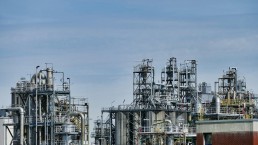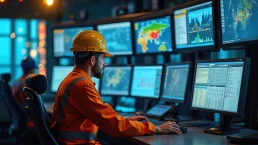Remote operations are a common necessity in industries such as Oil and Gas, Mining, and Construction. These environments often present unique safety challenges that require tailored solutions to ensure the well-being of workers. From extreme weather conditions to isolation and limited medical care, the risks are numerous and varied. This blog will explore the key safety challenges workers face in remote operational sites and provide a guide in implementing effective safety measures and protocols.
The Harsh Reality of Remote Environments
- Ensuring Connectivity in Harsh Environments
One of the most significant challenges in remote operations within heavy industries like Oil and Gas, Mining, and Construction is maintaining reliable connectivity in harsh environments. Effective communication is crucial for the safety and efficiency of operations, yet rugged terrain, extreme weather conditions, and the vastness of remote locations often compromise it. According to Deloitte, real-time data transmission enabled by robust connectivity solutions can lead to a 10-15% increase in productivity and a 15-20% reduction in operational costs.
Research by VDC Research highlights that ruggedized mobile devices, crucial for maintaining connectivity in extreme conditions, saw a 15% increase in adoption in these sectors from 2018 to 2021. Additionally, a study by the International Data Corporation (IDC) reveals that companies deploying satellite communication systems in remote areas have improved their operational efficiency by 20% and reduced safety incidents by 25%.
- Extreme Weather Conditions
Remote operational sites are often in areas with extreme weather conditions, such as severe cold, intense heat, or heavy rainfall. These conditions can lead to environmental hazards, equipment malfunctions, and serious health risks like hypothermia, heatstroke, and dehydration. Continuous tracking and monitoring of workers with tracking devices coupled with Body Vitals monitoring, hazardous gas level sensing, falls, lack of movement, geofencing, mustering, and various other alerts can largely reduce these health risks/hazards faced in extreme weather conditions.
Technology as a Safety Net
Advanced technologies such as GPS tracking and remote monitoring systems play a vital role in enhancing workforce safety in remote operations. These systems provide real-time data on worker locations, equipment status, and environmental conditions. By continuously monitoring these parameters, companies can quickly identify and respond to potential hazards, reducing the risk of accidents and injuries.
- Wearable Safety Devices
Wearable safety devices, such as smart helmets and health monitors, can provide real-time health data, including heart rate, body temperature, and fatigue levels. These devices can alert workers and supervisors to potential health issues before they become critical, allowing for timely interventions.
Building a Culture of Safety
- Comprehensive Safety Training
Providing workers with comprehensive safety training tailored to the specific risks of remote environments is crucial. This training should cover emergency response procedures, the use of safety equipment, and strategies for managing isolation and mental health. Regular drills and refresher courses can ensure that workers remain prepared for emergencies.
- Emergency Response Plans
Developing and implementing robust emergency response plans is essential for remote operations. These plans should outline procedures for medical emergencies, evacuations, and other crises. Ensuring that all workers are familiar with these plans and have access to necessary emergency supplies is critical for their safety.
Enhancing Communication and Connectivity
- Reliable Communication Systems
Ensuring reliable communication is vital in remote operations. Satellite phones, two-way radios, and connectivity are essential tools for maintaining contact with workers. Regular check-ins and a clear communication protocol can help in the early identification of issues and prompt response.
- Isolation and Mental Health Support
Isolation can significantly impact workers’ mental health, leading to stress, anxiety, and decreased productivity. Providing access to mental health resources, such as counseling services and stress management programs, can help mitigate these effects. Encouraging social interactions and creating a supportive work environment can also improve overall well-being.
Leveraging Data for Continuous Improvement
- Data Analytics for Safety
Collecting and analyzing data on safety incidents, near misses, and equipment performance can provide valuable insights into potential hazards and areas for improvement. Using data analytics, companies can identify patterns, predict future risks, and develop targeted safety interventions. This proactive approach ensures continuous improvement in safety protocols and practices.
Paving the Path to a Safer Tomorrow
Workforce safety in remote operations presents a complex array of challenges that require a multifaceted approach. By leveraging advanced technologies, providing comprehensive training, ensuring reliable communication, and fostering a culture of safety, companies can significantly enhance the safety and well-being of their workers. Addressing both the physical and mental health needs of workers in remote environments is essential for maintaining a productive and resilient workforce. Through these efforts, remote operations can achieve safer, more efficient, and more sustainable outcomes, ultimately protecting the most asset—its workforce.


